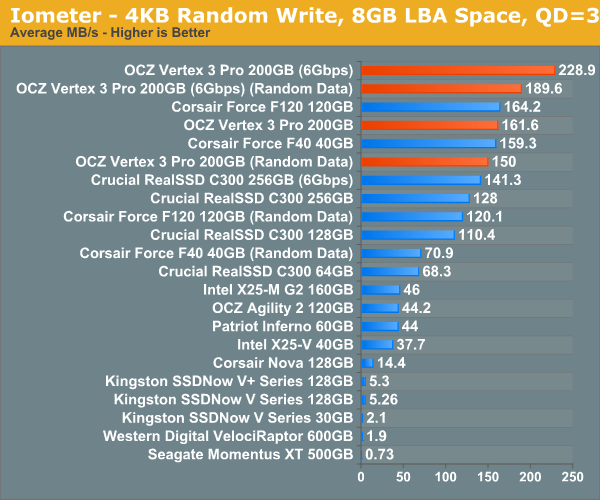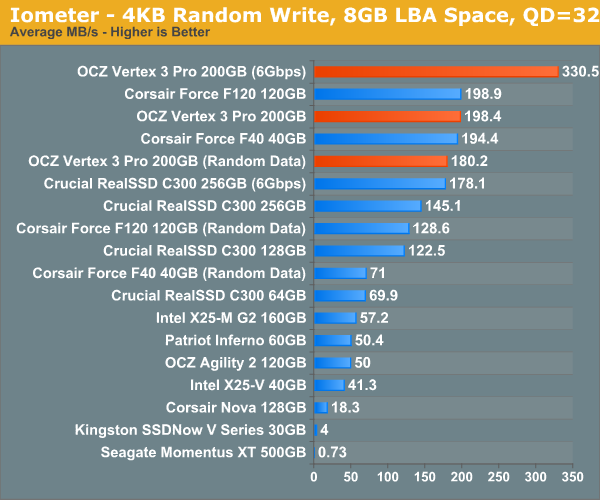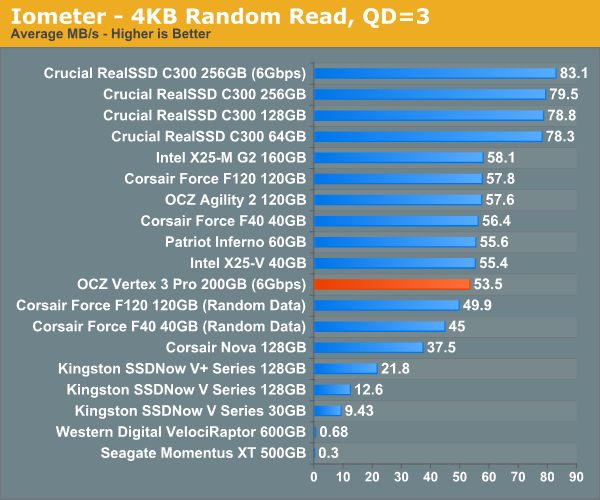OCZ Vertex 3 Pro Preview: The First SF-2500 SSD
by Anand Lal Shimpi on February 17, 2011 3:01 AM ESTThe Test
Note that I've pulled out our older results for the Kingston V+100. There were a couple of tests that had unusually high performance which I now believe was due the drive being run with a newer OS/software image than the rest of the older drives. I will be rerunning those benchmarks in the coming week.
I should also note that this is beta hardware running beta firmware. While the beta nature of the drive isn't really visible in any of our tests, I did attempt to use the Vertex 3 Pro as the primary drive in my 15-inch MacBook Pro on my trip to MWC. I did so with hopes of exposing any errors and bugs quicker than normal, and indeed I did. Under OS X on the MBP with a full image of tons of data/apps, the drive is basically unusable. I get super long read and write latency. I've already informed OCZ of the problem and I'd expect a solution before we get to final firmware. Often times actually using these drives is the only way to unmask issues like this.
| CPU |
Intel Core i7 965 running at 3.2GHz (Turbo & EIST Disabled) Intel Core i7 2600K running at 3.4GHz (Turbo & EIST Disabled) - for AT SB 2011 |
| Motherboard: |
Intel DX58SO (Intel X58) Intel H67 Motherboard |
| Chipset: |
Intel X58 + Marvell SATA 6Gbps PCIe Intel H67 |
| Chipset Drivers: |
Intel 9.1.1.1015 + Intel IMSM 8.9 Intel 9.1.1.1015 + Intel RST 10.2 |
| Memory: | Qimonda DDR3-1333 4 x 1GB (7-7-7-20) |
| Video Card: | eVGA GeForce GTX 285 |
| Video Drivers: | NVIDIA ForceWare 190.38 64-bit |
| Desktop Resolution: | 1920 x 1200 |
| OS: | Windows 7 x64 |
Random Read/Write Speed
The four corners of SSD performance are as follows: random read, random write, sequential read and sequential write speed. Random accesses are generally small in size, while sequential accesses tend to be larger and thus we have the four Iometer tests we use in all of our reviews.
Our first test writes 4KB in a completely random pattern over an 8GB space of the drive to simulate the sort of random access that you'd see on an OS drive (even this is more stressful than a normal desktop user would see). I perform three concurrent IOs and run the test for 3 minutes. The results reported are in average MB/s over the entire time. We use both standard pseudo randomly generated data for each write as well as fully random data to show you both the maximum and minimum performance offered by SandForce based drives in these tests. The average performance of SF drives will likely be somewhere in between the two values for each drive you see in the graphs. For an understanding of why this matters, read our original SandForce article.

Random write performance is much better on the SF-2500, not that it was bad to begin with on the SF-1200. In fact, the closest competitor is the SF-1200, the rest don't stand a chance.
Many of you have asked for random write performance at higher queue depths. What I have below is our 4KB random write test performed at a queue depth of 32 instead of 3. While the vast majority of desktop usage models experience queue depths of 0 - 5, higher depths are possible in heavy I/O (and multi-user) workloads:

Ramp up the queue depth and there's still tons of performance on the table. At 3Gbps the performance of the Vertex 3 Pro is actually no different than the SF-1200 based Corsair Force, the SF-2500 is made for 6Gbps controllers.











144 Comments
View All Comments
jwilliams4200 - Friday, February 18, 2011 - link
In that case, it would be helpful to print two after-TRIM benchmarks: (1) immediately after TRIM and (2) steady-state after-TRIM (i.e., TRIM, let the drive sit idle for long enough for GC to complete, then benchmark again)jcompagner - Thursday, February 17, 2011 - link
what i never understood or maybe i should read a bit more the previous articles, is that how come that a SSD can write many times faster then it can read?It seems to me that read is way easier to do then write...
vol7ron - Friday, February 18, 2011 - link
I originally thought that, but SSDs first write to the controller, which organizes the data for storing it to the disk. The major point is that the data can go anywhere in the array of NAND nodes and the list of the next available node in the stack is available almost immediately, whereas a read requires a hash lookup of where the data is stored, which means the seek could take longer to accomplish.I, as well, am not certain that's true, but that's my best guess.
AnnihilatorX - Saturday, February 19, 2011 - link
Only for Sandforce controllers.Sandforce compresses the incoming data at real time. If the incoming data is highly compressible, in a very extreme example, writting a 500MB blank text file, will be instantaneous. So you see 500MB/ms or something ridiculous.
It is also possible for write speeds to exceed read in burst when small amount of data is written to DRAM on other controllers
Soul_Master - Thursday, February 17, 2011 - link
For zero impact from source performance, I suggest to copy data from RAM drive to your test hard disk.Anand Lal Shimpi - Thursday, February 17, 2011 - link
That's a great suggestion. I ran out of time before I left the country but I'll be playing with it some more upon my return :)Take care,
Anand
MrBrownSound - Thursday, February 17, 2011 - link
I think the intel x25m was a pretty good control group to send the data from. I would auctally like to see the changes when sending the data through the RAM; that would be interesting.Hacp - Thursday, February 17, 2011 - link
Anand,You still direct your readers to your Vertex2 article but OCZ has changed its performance on those drives. Your results are no longer valid and it would be dishonest to link the old Vertex2 performance numbers in this new article when they do not reflect the new slower performance of the Vertex2 today.
Anand Lal Shimpi - Thursday, February 17, 2011 - link
I've seen the discussion and based on what I've seen it sounds like very poor decision making on OCZ's behalf. Unfortunately my 25nm drive didn't arrive before I left for MWC. I hope to have it by the time I get back next week and I'll run through the gamut of tests, updating as necessary. I also plan on speaking with OCZ about this. Let me get back to the office and I'll begin working on it :)As far as old Vertex 2 numbers go, I didn't actually use a Vertex 2 here (I don't believe any older numbers snuck in here). The Corsair Force F120 is the SF-1200 representative of choice in this test.
Take care,
Anand
Quindor - Thursday, February 17, 2011 - link
Good to hear that you are addressing the problems surrounding the Vertex 2 drives. There aren't many websites out there which deliver well thought through reviews and bechmarks such as Anandtech does, although some are getting better.I did some benchmarks on my own and with the new 25nm NAND the new 180GB OCZ Vertex2 can actually be slower then my more then a year old 120GB OCZ Vertex1.
If anyone is interested. They can find an overview of the benchmarks performed on the following page. https://picasaweb.google.com/quindor/Benchmarks#
Still, I would love to see an in depth comparsion as you are famous for. ;)
For my personal usage scenario (my own ESXi server), the speed decrease will be of minimal effect because running multiple template cloned guests, the dedup and compression should be able to do their work just fine. ;)